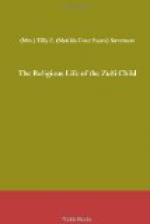large bunch of Spanish bayonets. While the Indian
from almost infancy looks upon any exhibition of feeling
when undergoing physical suffering as most cowardly
and unmanly, the severity of the pain inflicted by
the yucca switches in this ceremony is at times such
as to force tears from the eyes of the little ones,
but a boy over the age of five or six rarely flinches
under this ordeal. After passing the line the
godparent enters the Kiva of the North, where he is
met by a priest of the great fire order, who asks,
“Who is your K[=o]k-k[=o]?” When the godfather
replies, he is directed to select his boy’s plume.
The plumes which ornament the heads of the figures
have been previously wrapped in corn husks and carried
to the priest by the respective godfathers. The
godfather attaches the feather, which is a soft, downy
feather of the eagle, to the scalp-lock of the child.
The godparent is then given a drink of the holy water,
which is dipped from the bowl by the medicine man
with a shell attached to a long reed. The child
also drinks and repeats a prayer after his sponsor.
They then leave the kiva, and, taking a position on
the north side of the plaza, the child kneels and
clasps the bent knee of his godfather, who draws him
still closer with the blanket around him. Four
new characters of the K[=o]k-k[=o] now appear, the
Sai-[=a]-hli-a (see Plate XX). Each one of these
strikes the child four times across the back with
his yucca blades, having first tested with his foot
the thickness of the child’s clothing.
The child must not have anything over his back but
the one blanket, which is a gift from the godfather.
This ceremonial over, each child accompanies his godparent
to his home, where a choice meal is served.
The night ceremonial is conducted in two kivas, that
of the South and that of the East. The K[=o]k-k[=o]
for this ceremony divide and enter the two kivas.
The godparents sit upon the stone ledge which passes
around the room, whose walls are rectangular, and,
spreading his knees, the boy sits on the ledge between
them. To the right of the guardian his wife sits,
and to his left his sister. In case the wife is
not present, the older sister sits on the right and
a younger sister on the left. The father of the
Sun (P[=a]-oo-t[=i]-wa) enters and sits upon the throne
which has been arranged for him at the west end of
the room; this has a sacred blanket attached to the
wall and one to sit upon, the whole profusely ornamented
with white scarfs, woven belts, and many necklaces
of turquoise and other precious beads. To his
right and left sit the two young priests who prepared
the throne; to the left of the priest, on the left
of P[=a]-oo-t[=i]-wa, sit the high priest and priestess
of the Earth. The remainder of the ledge is filled
with the boys and their friends. Nai-[=u]-chi,
the living representative of [=A]h-ai-[=u]-ta, the
war god, sits to the left of the fire altar as you
enter and feeds the sacred flames. The Sae-lae-m[=o]-b[=i]-ya




